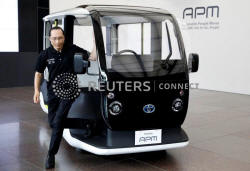Toyota fetches new way to use AI, self-drive tech in
Tokyo Games
 Send a link to a friend
Send a link to a friend
 [July 22, 2019] By
Naomi Tajitsu [July 22, 2019] By
Naomi Tajitsu
TOKYO (Reuters) - Miniature remote
controlled cars have proved to be a crowd pleaser at track and field
throwing events, but for the Tokyo 2020 Olympics Toyota Motor Corp is
upping the game with a hi-tech way to fetch javelins and hammers:
pint-sized, self-driving A.I. robot cars.
The Japanese automaker on Monday unveiled a prototype of its
next-generation field support robot, a miniature shuttle bus-shaped
contraption based on its "e-Palette" ride-sharing vehicle under
development, to be used at the Tokyo Games.
The vehicle, roughly the size of a toddler's ride-on toy car, can travel
at a maximum speed of 20 kilometers per hour and sports three cameras
and one lidar sensor which enable it to "see" its surroundings.
Draped around the top of its body is a band of LED lights which
illuminate when the vehicle uses artificial intelligence to follow event
officials toward the equipment hurled by athletes onto the pitch during
shot put, discus throw, hammer throw and javelin events.

After the equipment, which can weigh as much as eight kilograms for
hammers, is loaded into the vehicle by the official, a press of a button
located toward its front sends the car zipping back to athletes for
later use.
"Humans are better suited to picking up heavy equipment from the field,
but for quickly transporting them to their respective return depots,
that's a job that's best performed by robots," Takeshi Kuwabara, a
project planning manager who oversaw the robot's development, told
reporters.
"Our aim was to leverage the strengths of both humans and robots."
[to top of second column] |

An employee of Toyota Motor Corp. demonstrates an APM (Accessible
People Mover), a mobility vehicle designed expressly for use at the
Tokyo 2020 Olympic and Paralympic Games, during a press preview in
Tokyo, Japan July 18, 2019. REUTERS/Issei Kato

The trend of using miniature cars to fetch equipment at Olympics throwing events
goes back to the 2008 Beijing Games, where firey-red, rocket-shaped cars
scurried along the green to collect hammers, javelins and discuses.
At the 2012 Games in London, BMW developed and operated a fleet of blue and
orange miniature Mini Coopers to collect the discarded equipment, while
pint-sized green pick-up trucks performed the task at the Rio games in 2016.
A major sponsor of the Tokyo Games, Toyota also plans to dispatch virtual
reality enabled humanoid robots and mobile telepresence robots which will enable
spectators who cannot attend the games in person to experience events and meet
athletes remotely.
A fleet of robots on wheels developed by the automaker which can perform
household tasks for elderly people and hospital patients will also guide guests
to wheelchair seats and serve refreshments at events.
Toyota plans to use the games to showcase its new vehicle technologies ranging
from fuel-cell buses to on-demand, self-driving taxis, as it competes with
industry rivals and tech firms to develop affordable autonomous cars and
electric vehicles (EVs), along with on-demand transportation services.
(Reporting by Naomi Tajitsu; editing by Sudipto Ganguly)
[© 2019 Thomson Reuters. All rights
reserved.] Copyright 2019 Reuters. All rights reserved. This material may not be published,
broadcast, rewritten or redistributed.
Thompson Reuters is solely responsible for this content. |